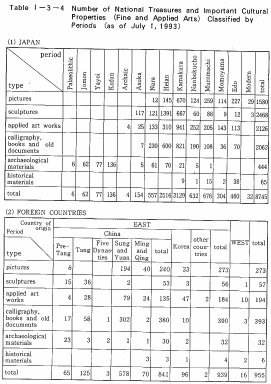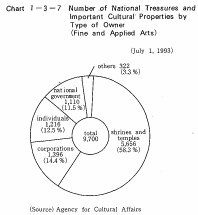| Home > Policy > White Paper, Notice, Announcement > White Paper > JAPANESE GOVERNMENT POLICIES IN EDUCATION, SCIENCE AND CULTURE 1993 > CHAPTER 3 �3 1 (1) | ||
Government designation of fine and applied arts began in 1897 with the enforcement of the Old Shrines and Temples Preservation Law. 9,700items, 830 of which are National Treasures, have now been designated under the present Law for the Protection of Cultural Properties. These items are classified by period, type and country of origin in Table l-3-4.
The "Seated Dainichi-Nyorai (IV1ahavairocana)" owned by the Enjo-ji Temple in Nara Prefecture and famous as the only existing work done by Unkei during his youth was designated as a National Treasure in l993. During the same year, thirty-eight other items were designated as Important Cultural Properties, including the "Notice Board on Market Laws" (owned by the Entoku-ji Temple in Gifu Prefecture), which is an important property indicating the nature of free market business as authorized by OdaNobunaga.

Custody and repair of National Treasures or Important Cultural Properties are the duties of their owners or custodial bodies. Shrines and temples OWII 21bOLlt 60 % Of National Treasures and Important Cultural Properties (fine 'and applied arts), while about 12 % are under individual ownership, as is shown in Chart I-3-7.

By their nature, cultural properties periodically require repairs. The Agency for Cultural Affairs conducts repairs on about 50 cultural properties annually. In fiscal 1992 and on into fiscal 1993, the Agency also carried out large scale maintenance and repair work on old documents from the Dazaifu Tenman-gu shrine in Fukuoka Prefecture. Another project is a four year maintenance and repair job that was begun on the bronze statues of "Yakushi Nyorai (Bhaisajaguru) and two attendants" (placed in lecture hall) of the Yakushi-ji temple in Nara Prefecture, to repair deterioration of the statues caused by expanding cracks.
Those National Treasures and Important Cultural Properties which are in the purchasing plan of the national government for preservation, and those which are in danger of being scattered and lost are purchased by the Agency for Cultural Affairs and exhibited to the public, thus assuring their preservation and utilization. In fiscal 1992 the Agency appropriated 1.998.2million yet for the purchase of nine items, including the painting of "Juichimen Kannon (Ekadasamukha)" in color on silk, a masterpiece representative of Buddhist paintings of the Heian Period and the only article from this period which depicts a single figure.
In addition to investigations which are carried out for the purpose of designating properties as National Treasures and Important Cultural Properties (fine and applied arts), there are also special investigations such as, for example, the program for "Concentrated Research Within a Given Location on Cultural Property Preservation", which has been carried out since1962. This research concerns cultural properties (fine and applied arts) which have great historical value both in and for Japanese culture, and has been carried out in the respective fields of r>ictures, sculptures, applied art works, calligraphy, books, old documents and historical materials. The purpose of this research is to quickly access the current state of cultural properties in order to prevent their being scattered or lost, and to draw up basic plans for their preservation. Prefectural boards of education and other agencies have maintained cooperation in conducting this research. By 1992, thirteen prefectures had been covered by this research, and cultural properties (fine and applied arts) located in Aichi Prefecture are to be investigated in 1993.
These various kinds of investigations promote the designation of Important Cultural Properties at the national level as well as the protection of cultural properties at the prefectural and municipal levels such as the designation of cultural properties. Besides the above-mentioned investigation on fine and applied arts, other investigations have been conducted on old documents and historical materials. making use of subsidies from the national government. To date, investigations have been conducted on 227 old documents and 146 historical materials, which have been useful in contributing to their designation and protection by the national and local governments.
In recent years a trend has arisen in which various investigations are carried out in combination with the compiling of prefectural or municipal history. Museums, art museums, historical and folklore museums and other facilities have been established by local governments where museum curators charge of history and fine arts have been making steady progress in there search of their respective areas, thus creating the framework for further investigations that will focus on the unique characteristics of local cultures.
The Law Controlling Possession, etc. of Firearms and Swords in principle prohibits the ownership of these weapons. Ownership is allowed, however, in exceptional cases of old style firearms such as matchlock guns, which are valued as works of art or as antiques, or in cases of swords that are valued as works of art, provided that these objects are registered with the Commissioner of the Agency for Cultural Affairs. This registration system is designed to afford protection to these objects that corresponds to the protection granted to cultural properties. 1,060 firearms and 18.742swords were registered in 1992.Those who wish to make swords which possess value as works of art must obtain recognition for each sword made from the Commissioner of the Agency for Cultural Affairs. 211 persons received recognition in 1992. 7 of whom were recognized for the first time.
| Back to Top | MEXT HOME |